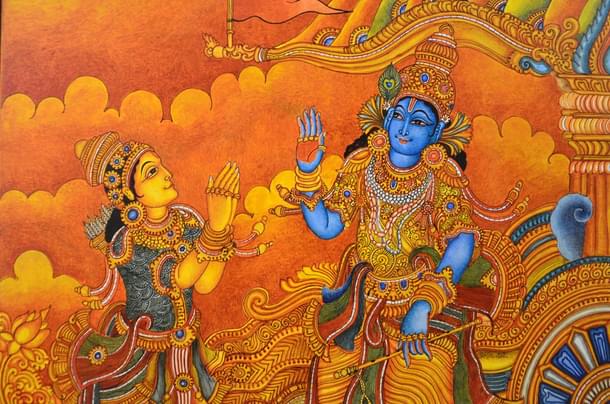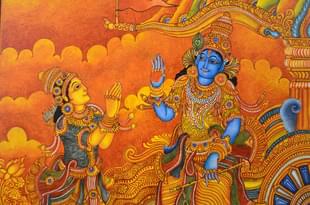Ideas
Gita Does Not Link Caste With Three Gunas, In Fact It Challenges Buddhist Perspective On The Issue
Aravindan Neelakandan
Aug 26, 2024, 06:11 PM | Updated 06:10 PM IST
Save & read from anywhere!
Bookmark stories for easy access on any device or the Swarajya app.


There is a standard model of Indian social history that is influenced heavily by colonial prejudices. According to this:
--The Vedic Hindu religion imposed a birth-based varna-jati system in India, placing Brahmins at the top.
--Buddha challenged this system. His was a revolution against Brahminism.
--As a counter revolution, Brahminism used various strategies including royal coups, manipulation of temporal power and Bhakti.
--The Bhagavad Gita is one of the chief texts of counter revolution. It gave the birth-based discrimination inviolable divine sanction.
This thesis was forcefully put forth by Dr Ambedkar, among others. Calling it the book of ‘counter revolution’, he states that beyond the divine sanction to the four varna system, Gita actually uses ‘a cruel perversion of the philosophy of Kapila’.
On 3 October, 1954, in a broadcast in the All India Radio (AIR), Dr. Ambedkar categorically rejected the Bhagavad Gita:
... I reject the Hindu Social Philosophy propounded in the Bhagvat Geeta based as it is, on the Triguna of the Sankhya philosophy which is in my judgement a cruel perversion of the philosophy of Kapila, and which had made the Caste System and the System of Graded Inequality the law of Hindu Social Life....
In the standard model of Indian social history, the Bhagavad Gita is often discussed in this context, but this positioning needs to be questioned and critiqued.
Does the Gita truly link birth-based jatis to the trigunas? Does it support, or does it challenge this connection between guna and jati?
Interestingly, Buddhism presents a stronger link between triguna categorization and jatis. Buddha identifies three types of people in society, each with different inner natures: those who do not long, those who long, and those who have transcended longing.
This classification aligns with the concepts of Tamasic, Rajasic, and Sattvic. In the Buddhist universe, this tri-nature justifies not only the fourfold societal system but also the ‘defiled trades.’
And who, monks, is the person that longs not? In this connexion, monks, suppose a certain man is born into a low family, the family of a scavenger or a hunter or a basket-weaver or a wheelwright or a sweeper, or in the family of some wretched man hard put to it to find a meal or earn a living, where food and clothes are hard, to get. Moreover he is ill-favoured, ugly, dwarfish, sickly, purblind, crooked, lame, or paralysed, with never a bite or sup, nor any clothes, vehicle, bed, dwelling or lights, no perfumes or flower-garlands.Aṅguttara Nikāya: Tika-nipāta 13:The book of the Gradual Sayings: Anguttara-Nikaya, Vol-I, Trans. F.L.Woodward,The Pali Text Society, Oxford, 1932, p.92
Buddha’s path to equanimity lies in renouncing society and joining the Sangha, the Buddhist order. But even this idealistic Sangha was for millennia not to be a practical reality.
Historian Uma Chakravarti explains this aspect of Buddhism in her work The Social Dimensions of Early Buddhism:
The linear order of castes of the Brahmanical texts, where the four vannas are ranked one below the other, were reduced to two strata by the Buddhists in one passage of the Majjhima Nikāya where King Pasendadi asks the Buddha whether there could be any distinction between the four Vaṇṇas. The Buddha answers by saying that among the four Vaṇṇas, the khattiyas and brāhmanas are pointed to as chief (settho) in the manner in which they are addressed, saluted and served. The vessa and sudda are opposed to the khattiya and brāhmana here in an implicit relationship of high and low. However, the khattiya and brahmana appear to stand in a relationship of equality between themselves.... A basic opposition between high and low appears in the context of jāti, kula, kamma (karma-work) and sippa (craft): thus there are high jātis and low jātis; high kulas and low kulas; high kamma and low kamma; and high sippas and low sippas. The conception of high and low is quite explicit in the classification of Jāti and kula.The Social Dimensions of Early Buddhism, Munshiram Manoharlal Publishers, 1996, p.101
In the context of Buddhist societal philosophy, which likely became dominant in ancient India, the Bhagavad Gita challenged the idea that gunas are innate and determine birth-based occupational jatis. The often-quoted line from the Gita, "catur-varnyam maya srstam guna-karma-vibhagasah" (BG: IV:13), offers a fresh perspective in this context.
In 2007 there was a scholarly debate on Gita and the birth-based varna in the online discussion forum of Religion in South Asia (RISA), a part of American Academy of Religions (AAR), particularly with respect to verse 4:13.
Belgian Indologist Dr. Koenraad Elst expressed sympathy for the 'reformist cause,' but remained skeptical about the verse rejecting birth-based varna. To him Krishna and Arjuna agreed that the mixing of varnas was not desirable. (For a complete criticism of the view of Dr Elst on Bhagavad Gita see the earlier Swarajya article here.)
Prof. Arvind Sharma, the Birks professor of Comparative Religion at McGill University, countered this, pointing out that while 'Arjuna uses the term varna-sankarah ‘in the sense of miscegenation (1.40-42), Kṛṣṇa seems to take it only in the sense of abandonment of duty (3.24)’.
Prof. Sharma based his argument on the authority of Manu Smriti (10:24) where three distinct reasons resulting in mixture or confusion are given. They are ‘infidelity among the castes, by the marrying of women unfit for marriage and neglect of one’s duties (svakarmaṇāṃ ca tyāgena).’
Of these it is only the third meaning of giving up one’s duty that Sri Krishna is concerned with and not mixed-marriages. Here one should also remember that earlier in the Mahabharata, Yudhishthira had already stated that from very ancient times marriages among the different hereditary communities had been happening and because of that the varna of an individual cannot be based on birth but only on his or her conduct.
In the 17 chapters of Gita, Krishna never uses even once, the terms repeatedly used by Arjuna – kula dharma and jati dharma. Instead He introduces the term svadharma and this arises out of svabhava which in turn comes from tri-guna dynamics of the individual.
This is a dynamic inner state which could be changed by the individual consciously - even by changing one's food habits. So it is not birth-based.
Buddha redefined the true Brahmana within his Bauddham Dhamma and Sangha but tacitly endorsed occupational hierarchy. In contrast, Sri Krishna in the Bhagavad Gita democratized Brahmanhood and the varna system, rejecting work hierarchy by elevating all work to moksha sadhana through karma yoga.
Thus the Bhagavad Gita was not a textbook of counter revolution but a revolution through bhakti, a transformative movement that targeted the psychological roots of social stagnation and exclusion.
[Article based on a chapter excerpt from the upcoming book: 'A Dharmic Social History of India']
Aravindan is a contributing editor at Swarajya.





